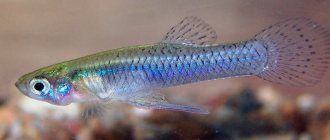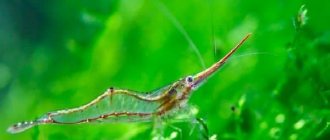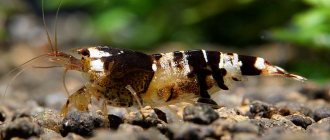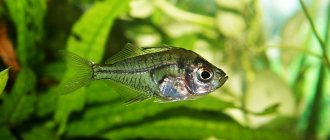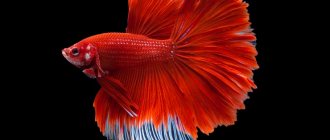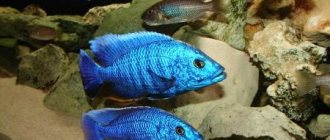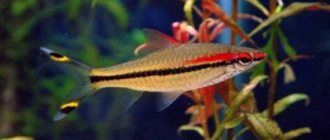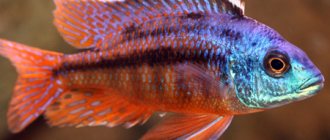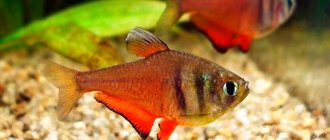Guppy
Simplicity of content:
Latin name: Guppy-Endler's Poecilia wingel
Lifespan: 3-5 years
Maximum size: female 4, male 2 cm.
Average cost: 100 rub.
Endler's guppies or Guppy-Endler's Poecilia wingel are tiny viviparous fish from the poeciliaceae family, class ray-finned, order Carp-toothed. Subject to the rules of maintenance and care, these dwarf guppies live in an aquarium for 3 to 5 years.
The discoverer of the dwarf guppy is Dr. Endler, who gave the fish his name. Interestingly, Guppy is also the name of the scientist who discovered the species of guppies.
Aquarists paid attention to these representatives of viviparous fish only 40 years after they were described in detail by J. Endler. Tiny guppies are on the verge of extinction. Degeneration is associated with environmental pollution and changes in the composition of water.
General information
Endler's guppy, or dwarf guppy (Poecilia wingei) is the closest relative of the well-known viviparous fish. And although the species was first described back in 1937, the fish became widespread in aquarium culture only decades later, after their “second discovery” by John Endler, after whom the species was named.
The main difference between Endler's guppy and its famous relative is size. The fish are miniature, males barely exceed two centimeters. But at the same time they have variegated colors, are unpretentious in maintenance and easily reproduce due to viviparity.
At the moment, a large number of forms with original colors have already been received.
Reviews
Poecilia wingei is a delight for beginners and experienced aquarists alike. Some people spend a lot of time watching guppies. Some aquarists keep only males in a decorative aquarium, while others cross different types of guppies.
Appearance
Endler's guppies have a small, slightly elongated body. Fish are characterized by pronounced sexual dimorphism. Males are smaller than females: males usually do not exceed 2.5 cm, females - 3.5 cm. Males are brightly colored: yellow, purple, red, orange, green spots are randomly located throughout the body. No two individuals have the same pattern. On the side there is a bean-shaped dark spot, the color intensity of which varies depending on environmental conditions. It is the first to become noticeable in fry, when the bright color has not yet appeared.
The caudal fin is forked. In the center it is transparent, but the last rays are brightly colored orange, yellow or red, sometimes with a dark edging. The dorsal fin may have a red or blue tint, as well as small spots. The anal fin is transformed into a gonopodium, an organ that allows the introduction of reproductive products directly into the abdomen of the female.
The body of females is uniformly colored gold or silver with a metallic sheen. At the moment, several breeding forms have been obtained that differ in color: snake skin, tiger, cobra and others.
Description
Endlers live in northeastern Venezuela. Smaller in size than other guppies.
Appearance
The maximum size of Endlers is 4 cm. The male’s oblong body has yellow, orange, purple and emerald spots. The eyes are big. The fins and tail are not as bushy as those of other guppies. The translucent tail is brightly colored around the edges. Females are silver or golden.
Behavior
Guppies are a friendly and active species. Endler's fish play, rushing around the entire aquarium. They stay in a flock.
Lifespan
Guppies live 1.5–5 years depending on their quality of life and water temperature. In warm water they grow faster, but live shorter.
Habitat
Endler's guppies were discovered and described by Franklin F. Bond in 1937. The researcher caught the first specimens in Lake Laguna de Patos (Venezuela). This unusual body of water was once part of the ocean, but isolation by a narrow strip of land and regular rains contributed to the water in the lake becoming fresh. However, the fish did not gain popularity at that time. Moreover, it was considered extinct for a long time, until the research expedition of Dr. John Endler discovered this species again. This was the “rebirth” of the fish, but this time the fish was infinitely loved by aquarists and spread widely throughout the world.
Endler's guppies - endemic to Venezuelan lakes
Endler's guppies are endemic to coastal Venezuelan lagoons, but their numbers are currently in decline due to pollution of their natural habitats. The species is considered endangered in nature, but thrives in aquariums.
Breeds
This relatively young fish species has become widespread in modern aquariums due to its rapid maturation, which is appreciated by breeders, creating hybrids that will become a worthy decoration for any aquarium. Natural Endler's guppies are characterized by black, green, orange and yellow shades, which are fantastically mixed when crossed. Elegant bright fish are individual, so there is no clear classification by variety .
Thanks to the unpretentiousness of the little ones and the amazing speed of their reproduction, modern breeders have been able to develop a variety of breeds, of which the most striking species of Endler's guppies are popular.
Basically, the breeds differ in color.
Gold
Endler's Gold guppy has a transparent tail and a golden body with red spots scattered chaotically. Keen aquarists consider this variety to be the most attractive.
Tiger
Endler's Tiger Guppy differs from the others in its original design. The presence on the body of the fish of dark and clearly defined stripes, vaguely reminiscent of tiger stripes. Bizarre combinations of many clear spots create a unique pattern, delicately honed by nature itself during rebirth, making Endler's Tiger guppy incredibly popular, both among beginners and experienced aquarists.
Cobra
Guppy Cobra is close in color to snake skin.
Venezuela
Venezuela is distinguished by a caudal fin shaped like a double sword and a remarkable dorsal fin that is elongated, like a scarf.
Japanese blue
The Japanese Blue Guppy has an exquisite neon bluish coloration with a distinctive darkish bean-shaped spot on its side.
Varieties of Endler's guppies
There are several subspecies of Endler's guppies, but they all differ only in their shape and color. As for the conditions of keeping and caring for pets, they are absolutely identical. Varieties:
- brindle
The subspecies got its name due to its characteristic coloring, reminiscent of a tiger skin. On a yellow, orange or golden background there are ornate thin black stripes that form intricate patterns throughout the body. - Blue (Japanese)
It has an amazing turquoise-blue scale color that shimmers in the light with a pearlescent sheen, making the fish appear silvery. Small dark spots may be present on the body and in the head area. - Gold
It is characterized by its bright, sparkling golden color and luxurious veil-shaped tail, which appears completely transparent in the aquatic environment. Red, orange and coral spots are randomly located along the entire body of the fish. - Cobra
One of the rarest and most valuable breeding species of dwarf guppies. Valued by aquarists for its unusual colors, reminiscent of snake skin. - Venezuelan
This fish can have any color, but a characteristic feature of its appearance that distinguishes it from its relatives is the dorsal fin - long and flowing, reminiscent of a chiffon scarf. The tail fin of the Venezuelan guppy is also quite unusual and has the shape of a pointed double sword. - Blonde . The color of this subspecies is dominated by light, pastel colors. The body of the fish can be painted silver, gray, or white. However, the multi-colored spots located along the body and the radiant tint of the scales make the blonde’s appearance bright and unusual.
Experts note that the color intensity of Endler's guppies can vary depending on the parameters of the aquatic environment, health status, diet and care.
Possible diseases
Endler's guppy is characterized by good health and good immunity. However, if the conditions are unsuitable, there are risks of developing a number of diseases:
- Mycobacteriosis . Symptoms of this disease are curvature of the spinal column, constant lack of appetite, refusal to eat, and pale color. Since this pathology is contagious, at the first suspicious signs the sick individual should be placed in a separate tank to avoid the spread of infection. Treatment is carried out with Kanamycin.
- Intoxication . Poor quality food, irregular cleaning of the aquarium, and pollution of the aquatic environment can cause poisoning. When intoxicated, the fish begins to breathe frequently and heavily, and its body becomes bright red. If such symptoms occur, it is necessary to check the water parameters, clean the aquarium and replace the liquid. If these steps do not give the desired effect, it is recommended to seek help from a veterinarian.
- Fin rot is a pathology that affects the fins of fish. Treatment is carried out using saline solutions and a number of drugs prescribed by a veterinarian.
Endler's guppies delight aquarists with their incredible beauty, bright colors, grace and elegance. At the same time, the fish are peaceful and undemanding in terms of care, omnivores, and therefore are considered an excellent choice not only for experienced aquarists, but also for beginners.
Content Features
To create favorable conditions, it is necessary to provide basic conditions for the normal life of fish in a home pond. The maintenance and care of this variety of guppies is simple. Considering that natural survival conditions were harsh, dwarf fish have excellent adaptability. The ability to survive and high immunity of babies help them easily tolerate temperature fluctuations and hard water. The range of 23-30 degrees is the most favorable water temperature in the aquarium, although the fish can easily tolerate less comfortable conditions, but not lower than 18 degrees
.
Guppies are platy fish, so they prefer slightly salted water. To do this, you can use both sea and table salt.
Due to their defenselessness, dwarf creatures require natural shelters in the reservoir, so it is recommended to equip the aquarium with algae. It is necessary to ensure good water filtration, but avoid strong currents, because it will be difficult for dwarf guppies to cope with it.
It is recommended to change a third of the water volume weekly, as fish need fresh water saturated with oxygen. Fish will die in stagnant water. But when creating the proper conditions for Endler's guppies, you should take into account that the fish that live in the upper layer of water jump excellently, so it is recommended to purchase a container with a lid for their habitat.
Aquarium
To keep a flock of Endler's guppies, a very small aquarium is suitable. They use so-called nanoaquariums, which are small containers of 40 liters or less. To saturate the aquatic environment with oxygen, a compressor is placed in the aquarium, but its operation should not create strong water movement (in their natural habitat, these small fish do not like large currents). Dwarf guppies are very active and can jump out of the water, so the aquarium must be equipped with a lid.
Water
To fill the aquarium with Endler's guppies, use settled water with medium hardness and a slightly alkaline reaction. The best temperature for these fish is considered to be 22-26 degrees. At temperatures above 26, accelerated development and aging of fish occurs.
Priming
The bottom of an aquarium with dwarf guppies is covered with small river pebbles or coarse sand and densely planted with algae. This will bring the fish’s living conditions closer to natural ones, since in nature fish like to hide in thickets. They use plants that, when growing, reach the surface of the water and floating algae. The lighting of the aquarium should be dim – in bright light the fish turn pale.
Water parameters
Water temperature 22–28 degrees Acidity 6.7–8 pH Hardness 4–17 dGh Water movement is weak Poecilia wingei tolerates temperature rises of up to 30 degrees and drops of up to 18 degrees. Although Endlers are freshwater fish, lightly salted water is acceptable. To do this, use sea or table salt without additives. Salt concentration no more than 1 tbsp. l (30 g) per 10 liters of water.
Remember that salt water is not suitable for some other aquarium inhabitants. Change a third of the total volume of water once a week. Combine water changes with cleaning the soil and aquarium glass.
Plants
Endlers require dense vegetation. Suitable floating and rooted aquarium plants:
Vallisneria; Elodea; Java moss; hornwort; duckweed.
Equipment
To maintain Endlers, standard equipment is required:
filter; compressor; heater.
Make sure that the filter does not create a strong flow of water. When purchasing, pay attention to its characteristics. A heater will be required if the room is not warm enough. Place a thermometer in the aquarium to monitor temperature changes.
Lighting
Choose lighting based on the plants. Remember that if the light is too bright, guppies will turn pale.
What and why do fish get sick?
This variety of aquarium fish is considered resistant to various diseases, but high immunity is formed only under good conditions. It is worth remembering that some factors have a detrimental effect on pets.
So, at elevated temperatures, they will not have enough oxygen and the fish will begin to suffocate, and with a weak oxygen supply, guppies, especially males, grow slowly.
Due to too long lighting (more than 12 hours a day), the color of the fish becomes pale, and females develop infertility.
Curvature of the spine is common. This defect appears with poor aeration and due to poor nutrition of the fry.
Compatibility
Endler's guppy is a peaceful fish that gets along well with any calm species of small fish. Good neighbors will be: neons, rasboras, zebrafish, cardinals, corydoras. You should not plant with active barbs; they can bite the fins of dwarf guppies. Also, you should not keep them with ordinary guppies (Poecilia reticulata), because the species are capable of interbreeding with each other to form hybrids, which will negatively affect the purity of the breed. The fish gets along well with shrimp, such as cherries.
It is strictly forbidden to keep them with large aggressive species, because the dwarf fish will be eaten.
Behavior and lifestyle
The fish are peaceful, schooling and very active. Easily adjusted to any acceptable water parameters. A small flock can even be kept in a nano-aquarium.
Compatibility with other types
Endlers are peace-loving. They get along well with small and medium-sized peaceful fish. Intraspecific aggression is also absent. Males never start fights among themselves, and females can show the right to territory, but they do this without malice and, usually, do not cause trouble to other underwater inhabitants.
Suitable neighbors are:
- zebrafish;
- iris;
- tetras;
- mollies;
- swordtails;
- cardinals.
It is not recommended to keep them with ordinary guppies to preserve the purity of the species.
How to distinguish a male from a female?
It is not difficult to distinguish male and female Endler's guppy.
Individuals of different sexes, first of all, differ in size - the female dwarf guppies are always larger than the male.
Male individuals are brighter in color. On the entire surface of the body of males, spots of different colors with neon reflections are clearly visible - orange, red, bright yellow or emerald. Oval spots are scattered randomly on the sides of the body, the clarity of which may vary. The lush caudal fin is painted in bright colors, the colorless area in the center is outlined by a dark stripe. The fin near the anus is modified into a gonopodium (a special tube that is used during reproduction).
Females are more modestly colored. Their bodies are mostly silver or golden faded tones with a slightly noticeable metallic sheen. Some females have a black spot on the side of the abdomen.
Introduction
Small and incredibly diverse aquarium fish, guppies are known to everyone.
Not long ago, dwarf guppies or Endler's guppies began to appear in home aquariums. These miniature creatures were discovered in the rivers of Venezuela, where they were first observed and described by Franklin F. Bond. Dwarf guppies became known to a wide circle of aquarists after they were once again discovered by John Endler (this happened in 1975). In the literature, dwarf guppies are most often called “Endler’s guppies”. Endler's guppies were first found in Laguna da Patos, which is located in northern Venezuela in 1935. At first, guppies of this species lived in a salty backwater, which was separated from the ocean waters by a narrow strip of land. Over time, numerous precipitations made the water in this lake fresh. At the time of the discovery of this species of fish, the reservoir was filled with algae, with hard water at elevated temperatures. Currently, dwarf guppies are classified as an endangered species.
— Advertising —
The size of Endler's guppies is really very small: males grow no more than 2-2.5 cm, females are slightly longer - 3.5 cm. The body of the fish is slightly elongated and flattened on the sides. The body of females has one color - golden or silver. There is a small dot at the back of the abdomen that indicates the formation and development of embryos. The body of males is brightly colored - specimens are known to be red, orange and purple with bright emerald spots and black bean-shaped markings on the sides. These spots become discolored in case of excitement or stress. The color of the dorsal fin varies from red to shades of blue; there may be spots of various colors on the surface of the fin. The central part of the caudal fin is transparent, the side rays are yellow, orange or red. Sometimes there is a black border along the edge of the side rays of the tail.
Endler's guppies do not live long - only 2-3 years.
Endler's guppy diseases
Like regular guppies, Endler's guppies have good immunity and resistance to diseases.
But it should be remembered that fish of this species are heat-loving creatures and are very sensitive to any change in temperature. If the temperature in the aquarium is too high (more than 28 degrees), the fish suffocate due to lack of oxygen.
At low temperatures (below 20 degrees), the health of the fish deteriorates sharply, which often leads to the loss of a pet.
Basic compliance with the temperature regime in the home of Endler's guppies will help to avoid many problems that are associated with their health.
If the fish’s condition does not return to normal, you should contact a specialist and begin drug treatment.
Interesting Facts
- A female Endler's guppy can store a male's sperm in her body for three months and can give birth three times without a male. Professionals use this and, by crossing individuals of different breeds, expect three broods of fry.
- Female Endler's guppies are inconspicuous and inconspicuous. But each male of this species of guppy has a unique coloring, which is not repeated in other individuals of the same breed.
- It turns out that female guppies are capable of becoming males and fertilizing others. This rather rare phenomenon is described in many scientific sources. There is a known case when a female who lived alone in an aquarium gave birth to fry.
Reproduction
Playful babies are unusually active; if there are no females, then the males are not aggressive towards each other. But females, feeling a lack of territory, are capable of bullying their rivals. To create comfortable conditions for the flock, it is recommended to choose a container of at least 50 liters. There should be more females than males. Reproduction does not require special conditions. Males constantly chase females in order to fertilize them. Viviparous individuals spawn fry every 24 days. New offspring appear in numbers from 5 to 25 pieces. Parents do not suffer from cannibalism, but for safety it is still worth placing the babies in a separate container
. Young males acquire permanent color after 3-4 weeks; in females this process lasts longer and takes up to 8 weeks. A couple of months after birth, the female is ready for fertilization.
To prevent the degeneration of Endler's guppies, it is recommended to purchase males from outside, updating the gene pool.
Adviсe
- To update the gene pool, periodically acquire new males.
- Place the aquarium away from sunlight to prevent algal blooms.
- To control the number of fry, add platies or mollies to the aquarium.
- In the summer, cool the water with ice packs.
- Keep newly acquired fish separately for 3-4 weeks. Monitor their condition, if no diseases appear, transplant the fish into a common aquarium.
- The transition from one water parameters to others should be smooth. You cannot move a newly purchased specimen from the package to the aquarium. Add new water to the bag gradually at intervals of 15–20 minutes. When most of the water has been replaced, release the fish into the aquarium.
Poecilia wingei is an endangered species due to pollution. The natural population of Endlers remains in only one lake.
Previous
FishCompatibility of all cichlids with other fish in the aquarium
Next
FishRecommendations for caring for swordtail fish in an aquarium
Features of feeding
Dwarf guppies are not picky eaters: omnivorous fish happily eat a variety of frozen, live, and plate-like artificial foods. It must be taken into account that fish have a very small mouth, so you should give preference to small or frozen food that can be easily pinched off.
Due to the peculiarities of the functioning of the gastrointestinal tract of Endler's guppies, experts recommend choosing food that contains spirulina or other greens, because dwarf pets require a high content of plant substances in the supplement.
Interesting fact about Endler's guppies
Common guppies and Endler's guppies have been spread by humans on all continents to combat malaria. Fish eat the larvae of malaria mosquitoes in warm waters. It is difficult to say how reliable this fact is. Gambusia , always saved a friend from malaria . Nevertheless, such a legend is also widespread about guppies.
Small populations of guppies can be found even in our northern Country. For example, in the Moscow River in places where warm waters are discharged, in Lyubertsy, and in other areas. These fish can also be seen in Tver, Yaroslavl, Nizhny Novgorod in the warm waters of the discharge.
Breeding
Endler's guppies can breed without problems in a community aquarium. But only on the condition that there are no ordinary guppies in it. To maintain the purity of the breed, special spawning aquariums are used.
Conditions for reproduction
Under good conditions, fish do not need human help - they reproduce independently without any outside participation. The main thing is that the aquarium has good aeration and filtration, a lot of plants and high-quality water.
How to create conditions for a pregnant female:
- determine the gestational age and transplant the fish into a separate aquarium in time; in the aquarium, no one will prevent it from safely giving birth to fry;
- immediately before giving birth, it is prohibited to disturb the female in any way.
Guppies are viviparous fish, so they produce offspring that are completely ready for independent existence. Birth frequency is every 3-4 weeks.
Endler females, unlike many other fish, rarely eat their offspring. But such a development cannot be ruled out. Therefore, in order not to risk the young, the female that has given birth is immediately placed back in the general aquarium.
How to determine the gestational age?
Aquarists need to monitor pregnant fish in order to transfer them to the nursery in a timely manner - on the 19-20th day of pregnancy. That is, 3-4 days before giving birth - so that the stress before childbirth is minimal. A female's pregnancy must be determined with maximum accuracy - with an error of 1-2 days.
What to pay attention to when determining the duration of pregnancy:
- look at the back of the abdomen - near the anal fin, a dark spot should appear here;
- the abdomen acquires a square outline;
- if the area near the anus is swollen, it means there are only a few days left before the birth and it’s time to transfer the female to the nursery.
If everything is done correctly and the fish is transferred to a separate aquarium in time, it will get used to the new conditions and will not have stress before giving birth. This means that the fry will be born active and healthy.
Preparation of the nursery and childbirth
In order for a pregnant female to feel comfortable and calm in the hatchery, it is necessary to properly prepare and equip it.
What kind of depositor should there be:
- volume - from 12 to 30 l;
- soil - not needed;
- compressor and internal filter - must work around the clock;
- water flow is excluded;
- plants and moss are a must, they will be needed for the comfort of the fry.
Soil is not loaded into the sedimentation tank so that it is as clean as possible.
The preparation of the aquarium begins a few days before the female is transplanted so that bio-equilibrium is established in it.
If everything is done correctly, the female will produce approximately 3 dozen fry. If the fish cannot give birth on its own, labor is stimulated by placing a male in the fish, raising the temperature a couple of degrees and adding fresh water.
How to care for babies?
The fry are born quite large. They are able to eat small dry food immediately after birth. It is also recommended to give the fry Artemia nauplii - this is a highly nutritious live food containing substances for the growth of the fry.
The fry are fed 3 to 5 times a day. Small guppies grow rapidly and after a month and a half they can be transferred to a large aquarium with adult fish. At the age of one month, males acquire full color and can reproduce.


